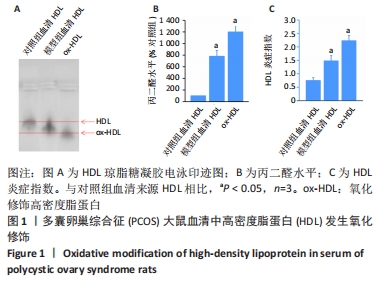[1] PALOMBA S, PILTONEN TT, GIUDICE LC. Endometrial function in women with polycystic ovary syndrome: a comprehensive review. Hum Reprod Update. 2021;27(3):584-618.
[2] JOHAM AE, NORMAN RJ, STENER-VICTORIN E, et al. Polycystic ovary syndrome. Lancet Diabetes Endocrinol. 2022;10(9):668-680.
[3] SADEGHI HM, ADELI I, CALINA D, et al. Polycystic Ovary Syndrome: A Comprehensive Review of Pathogenesis, Management, and Drug Repurposing. Int J Mol Sci. 2022;23(2):583.
[4] HUDDLESTON HG, DOKRAS A. Diagnosis and Treatment of Polycystic Ovary Syndrome. JAMA. 2022;327(3):274-275.
[5] PATEL S. Polycystic ovary syndrome (PCOS), an inflammatory, systemic, lifestyle endocrinopathy. J Steroid Biochem Mol Biol. 2018;182:27-36.
[6] MOUSA A, JOHAM A, BOYLE J. Polycystic Ovary Syndrome. Semin Reprod Med. 2021;39(3-04):69-70.
[7] ZHONG P, GUAN B, LIN Y, et al. Changes in inflammatory factors, oxidative stress, glucose and lipid metabolism, and insulin resistance in patients with polycystic ovary syndrome. Cell Mol Biol (Noisy-le-grand). 2022;67(5):45-50.
[8] PEROVIC BLAGOJEVIC IM, VEKIC JZ, MACUT DP, et al. Overweight and obesity in polycystic ovary syndrome: association with inflammation, oxidative stress and dyslipidaemia. Br J Nutr. 2022;128(4):604-612.
[9] ZHANG J, ZHANG Y, LIU H, et al. Antioxidant properties of high-density lipoproteins are impaired in women with polycystic ovary syndrome. Fertil Steril. 2015;103(5):1346-1354.
[10] 郭琴,骆婕,廖凤儿,等.FBW7通过促进NOX1降解抑制ox-LDL诱导的颗粒细胞凋亡[J].中国病理生理杂志,2020,36(12):2234-2243.
[11] WANG L, LI H, TANG X, et al. Oxidized high-density lipoprotein enhances endocrine disorders and ovarian damage in rats. J Cell Mol Med. 2021;25(17):8115-8126.
[12] IBRAHIM YF, ALORABI M, ABDELZAHER WY, et al. Diacerein ameliorates letrozole-induced polycystic ovarian syndrome in rats. Biomed Pharmacother. 2022;149:112870.
[13] PETERS CN, EVANS IE. Automated Processing of Plasma Samples for Lipoprotein Separation by Rate-Zonal Ultracentrifugation. J Lab Autom. 2016;21(6):756-764.
[14] PIOMBONI P, FOCARELLI R, CAPALDO A, et al. Protein modification as oxidative stress marker in follicular fluid from women with polycystic ovary syndrome: the effect of inositol and metformin. J Assist Reprod Genet. 2014;31(10):1269-1276.
[15] GONG Y, LUO S, FAN P, et al. Growth hormone activates PI3K/Akt signaling and inhibits ROS accumulation and apoptosis in granulosa cells of patients with polycystic ovary syndrome. Reprod Biol Endocrinol. 2020;18(1):121.
[16] CAO J, HUO P, CUI K, et al. Follicular fluid-derived exosomal miR-143-3p/miR-155-5p regulate follicular dysplasia by modulating glycolysis in granulosa cells in polycystic ovary syndrome. Cell Commun Signal. 2022;20(1):61.
[17] MOHAMMADI M. Oxidative Stress and Polycystic Ovary Syndrome: A Brief Review. Int J Prev Med. 2019;10:86.
[18] ZHANG Q, REN J, WANG F, et al. Mitochondrial and glucose metabolic dysfunctions in granulosa cells induce impaired oocytes of polycystic ovary syndrome through Sirtuin 3. Free Radic Biol Med. 2022;187:1-16.
[19] TAN W, DAI F, YANG D, et al. MiR-93-5p promotes granulosa cell apoptosis and ferroptosis by the NF-kB signaling pathway in polycystic ovary syndrome. Front Immunol. 2022;13:967151.
[20] SOLEK P, MAJCHROWICZ L, KOZIOROWSKI M. Aloe arborescens juice prevents EMF-induced oxidative stress and thus protects from pathophysiology in the male reproductive system in vitro. Environ Res. 2018;166:141-149.
[21] SUN J, GUO Y, FAN Y, et al. Decreased expression of IDH1 by chronic unpredictable stress suppresses proliferation and accelerates senescence of granulosa cells through ROS activated MAPK signaling pathways. Free Radic Biol Med. 2021;169:122-136.
[22] AN R, WANG X, YANG L, et al. Polystyrene microplastics cause granulosa cells apoptosis and fibrosis in ovary through oxidative stress in rats. Toxicology. 2021;449:152665.
[23] ZHOU XY, ZHANG J, LI Y, et al. Advanced Oxidation Protein Products Induce G1/G0-Phase Arrest in Ovarian Granulosa Cells via the ROS-JNK/p38 MAPK-p21 Pathway in Premature Ovarian Insufficiency. Oxid Med Cell Longev. 2021;2021:6634718.
[24] WANG M, LI Y, GAO Y, et al. Vitamin E regulates bovine granulosa cell apoptosis via NRF2-mediated defence mechanism by activating PI3K/AKT and ERK1/2 signalling pathways. Reprod Domest Anim. 2021;56(8):1066-1084.
[25] 傅明德.人血浆高密度脂蛋白亚类分布与动脉粥样硬化[J].中国动脉硬化杂志,2012,20(10):865-870.
[26] DENG S, XU Y, ZHENG L. HDL Structure. Adv Exp Med Biol. 2022;1377: 1-11.
[27] WANG Y, LIU H, FAN P, et al. Evidence for association between paraoxonase 1 gene polymorphisms and polycystic ovarian syndrome in southwest Chinese women. Eur J Endocrinol. 2012;166(5):877-885.
[28] DEAKIN S, MOREN X, JAMES RW. HDL oxidation compromises its influence on paraoxonase-1 secretion and its capacity to modulate enzyme activity. Arterioscler Thromb Vasc Biol. 2007;27(5):1146-1152.
[29] FAN P, LIU HW, WAN DH, et al. Altered distribution of plasma platelet-activating factor acetylhydrolase between high-density lipoprotein and low-density lipoprotein in patients with polycystic ovary syndrome. Fertil Steril. 2009;92(6):2054-2057.
[30] ZHANG Q, JIANG Z, XU Y. HDL and Oxidation. Adv Exp Med Biol. 2022; 1377:63-77.
[31] GAO D, ASHRAF MZ, ZHANG L, et al. Cross-linking modifications of HDL apoproteins by oxidized phospholipids: structural characterization, in vivo detection, and functional implications. J Biol Chem. 2020;295(7): 1973-1984. |





